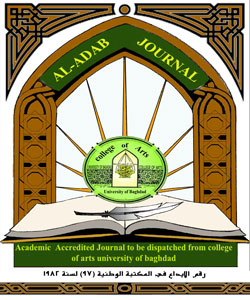ثنائیة المكان في روایة "یومیات هر" لإمیلي نصر الله
DOI:
https://doi.org/10.31973/aj.v1i131.434الكلمات المفتاحية:
ثنائیات المكان، قصص الأولاد، الروایات الحربیة، إمیلي نصر اللهالملخص
إن عنصر المكان وتوظیفه في داخل بنیة الروایة یعد من أهم العناصر والتقنیات في الأدب الروائي المعاصر ولا سيما في الروایات التي تعنی بموضوع الحرب؛ ذلك أن الحروب تنشب غالبا لأجل السیطرة علی أراضي الخصم، فالروایات التي تلقي الضوء علی الحرب وآثارها من الدمار والقتل والهجرة كلها تتركز علی عنصر المكان كمكون أساسي بارز. تهدف هذه الدراسة إلى معالجة موضوع المكان وثنائیاته في روایة یومیات هر لإمیلی نصر الله) 1931-2018) -كاتبة المرأة والحرب والهجرة- التي تنظر إلى الحرب وآثارها في هذه الروایة من وجهة نظر مختلفة تماما وذلك إنها تحكی قصة القطط الشاردة ومصیرها أثناء الحرب وعلاقاتها بالناس ولا سيما الأولاد، علی لسان راو خاص وهو قط اسمه "زیكو". من أهم النتائج التي توصلنا إليها في هذه الدراسة هو أن الأمكنة الواقعیة في هذه الروایة تتوزع بین الداخل والخارج حسب الإحساس الذي یتبادر إلى الشخصیات الساكنة فيها. فالأمكنة المنفتحة لا تعد مصدرا دائما للسعادة، ویمكن أن تتبادل الأمكنة الأدوار فيما بینها معتمدة علی شعور سكانها تجاه المكان. لقد جرى توظیف المكان في الروایة وعلاقته بالشخصیات، لتمثیل الخسائر المادیة والروحیة التي لحقت به وبقاطنیه، وكذلك لبیان العلاقات الإنسانیة ضمن الكوارث التي كان یمرّ بها الناس من المقاتلین والسكان العادیین وكذلك الحیوانات الشاردة في خضم الحرب الأهلیة اللبنانیة.
التنزيلات
المراجع
Albaki, Petrus. (2011). “Migration as a Challenge for the Lebanese Economy: Historical roots, The current position and Future Prospect”, National Defense Journal. No. 76.
Ali Zeitoun, Mahdi. (2011). On Literary Criticism Intellectuality, Space, Narration. Beirut: Dar al-Farabi.
Alizaitoun, Lina. (2014). The Narrative World and its Implications in the Works of Awad Shaban. Beirut: Dar al-Awdah.
Almarzoughi, Samir & Jamil Shaker, (1985). Introduction to Theories of the Story, Analysis and Comparison. Baghdad; Institution of General Cultural Affairs.
Alnablesi, Shaker. (1994). Aesthetics of the Place in Arabic Narration. Beirut: Arabic Institution of Studies and Distribution.
Alnasir, Yasin, (2010). Novel and Space, Study of Narrative Space. Damascus: Dar Ninawa for Studies and Distribution. N.2.
Bachelard, Gaston, (1984). Poetics of Space. Translated by Ghaleb Halseh, Beirut: University Foundation for studies, publishing and Distribution, N.2.
Bahrawi, Hasan. (1998). The Structure of the Narrative form (Space, Time, Characteristic). Beirut: Arabic Cultural Center.
Ben Ali, Lounis, (2015). Narrative atmosphere in the Algerian novel, Princess of Moriscan by Mohammed Dib. Algeria: Diffusion Publication, Algeria.
Eghagh, Ghadah. (2001). The City in the Modern Poetry: A Study of the Aesthetic Reception of the Place. Damascus: Unity of Arab book.
Ghasem, Siza. (2004). Structure of the Novel: Comparative Study of Najib Mahfoud’s Trilogy. Cairo: Alosrah Library.
Hanieh, Jawadi. (2013). The Picture of the Place and its Implications in Wasini al-Araj’s Novels. M.A thesis. University of Mohammed Khadir Biskra.
Hashem, Mohammed Hashem & Maryam Jalali, (2016). “The Impact of the Military Siege in Beirut on Using places and their implication in Maryam Tati’s Selection by Sadi Yousef.” Journal of Critical Illuminations. Azad University, Sixth year, N24.
Jendari, Ebrahim. (2001). Fiction Atmosphere from Jebra Ibrahim Jebra’s Point of View. Baghdad: General Cultural Affairs House.
Kahloush, Fathieh. (2008). The Eloquence of the Place; Studying the Position of Poetic Text. Beirut: Arabic Publication.
Kanjian Kenari, Ali & Hawra Reshno. (1991). “Woman and Migration and Al-eghla Aks Elzaman, a Novel by Emili Nasrollah”. Journal of Arabic Studies. University of Semnan. N.10.
Kouk, Miryam. (2005). Voices of the War Sidelines, Women Writing on Civil War in Lebanon. Translated by Salah Hazin. Cairo: Supreme Council of Culture.
Lotman, Yuri, (1988). “The Problems of the Artistic Place. Translated by Siza Ghasem”. Journal of Comparative Rhetoric. Cairo. American University.
Mansouri, Wahibeh & Selhieh Maouni. (2013). Algerian Political Speech in Yasmineh Saleh’s novel, A Home of Glass. Introduction of the M.A thesis. Bejayah University.
Othman, Abdelfattah. (1982). The Structure of the Novel. Egypt: Shabab Library.
Rezwan, Abdullah. (2009). Narrative Structure, Comparative Study of the Arabic Short Story. Publishing and distribution channels.
Riad Wetar. Mohammed. (2000). Personality of the Intellectual in Syrian Arab Novel. Damascus: Unity of Arabs Book.
Roshanfekr, Akram. (1994). Woman in Lebanese Literature According to the Works of Emeli Nasrollah. Rasht: Guil Inscription.
Rostam Pourmaleki, Roghayeh, Fatemeh Shirzadeh. (1991). “Spatial Polarity in Mahmoud Darwish’s Modern Poetry”. Journal of Arabic Studies. Pardis University of Tehran. N.9.
Sabri, Hafez. (1984). “A Study of the Modern Novel “Malek Alhazin”, Modernity and Spatial Corporeality of the Novelist’s Vision”. Fosoul Journal. N.4.
Sadieh, Ben Yahya, (2008). The Signification of the Place in the Novel, Passer-by a Bed, M.A thesis, Algeria University.
Shaban, Rahmah. (2014-15), The Picture of the City in “Refraction” by Mohammed Fallah. M.A thesis, Fculty of Arts and Languages, University of Mohammed Khadeer Biskra.
Sweidan, Sami. (2006). Narrative Spaces and Imagination Orbits (war and identity in Arabic Narration). Beirut: House of Arts.
Wellek, Rene & Austin Warren. (1987). Literary Theory. Translated by Mohei Aldin Sobhi. Beirut : Arabic Intuition of studies and distribution.
Zaeinaldin, Nawal. (2003). Novels of Yousef Edris. Cairo: Dar al-Gabba for publishing and distribution.
Zeydan, Joseph. (1999). Sources of Feminine Literature. Beirut: Arab Foundation of Study and Distribution.
التنزيلات
منشور
إصدار
القسم
الرخصة
:حقوق الطبع والنشر والترخيص
بالنسبة لجميع البحوث المنشورة في مجلة الآداب، يحتفظ الباحثون بحقوق النشر. يتم ترخيص البحوث بموجب ترخيص Creative Commons CC BY 4.0 المفتوح ، مما يعني أنه يجوز لأي شخص تنزيل البحث وقراءته مجانًا. بالإضافة إلى ذلك ، يجوز إعادة استخدام البحث واقتباسه شريطة أن يتم الاستشهاد المصدر المنشور الأصلي. تتيح هذه الشروط الاستخدام الأقصى لعمل الباحث وعرضه.
:إعادة إنتاج البحوث المنشورة من الناشرين الآخرين
من الضروري للغاية أن يحصل الباحثون على إذن لإعادة إنتاج أي بحث منشورة (أشكال أو مخططات أو جداول أو أي مقتطفات من نص) لا يدخل في نطاق الملكية العامة أو لا يملكون حقوق نشرها. يجب أن يطلب الباحثون إذنًا من مؤلف حقوق النشر (عادة ما يكون الناشر).
يطلب الإذن في الحالات التالية:
بحوثك الخاصة المنشورة من قِبل ناشرين آخرين ولم تحتفظ بحقوق النشر الخاصة بها.
مقتطفات كبيرة من بحوث أي شخص أو سلسلة من البحوث المنشورة.
استخدم الجداول والرسوم البيانية والمخططات والمخططات والأعمال الفنية إذا لم يتم التعديل عليها.
الصور الفوتوغرافية التي لا تملك حقوق لنشرها.
لا يطلب الإذن في الحالات التالية:
إعادة بناء الجدول الخاص بك مع البيانات المنشورة بالفعل في مكان آخر. يرجى ملاحظة أنه في هذه الحالة يجب عليك ذكر مصدر البيانات في شكل "بيانات من ..." أو "مقتبس من ...".
تعتبر عروض الأسعار القصيرة معقولة الاستخدام العادل ، وبالتالي لا تتطلب إذنًا.
الرسوم البيانية ، الرسوم البيانية ، المخططات ، الأعمال الفنية التي أعاد الباحث رسمها بالكامل والتي تم تغييرها بشكل ملحوظ إلى درجة لا تتطلب الاعتراف.
الحصول على إذن
لتجنب التأخير غير الضروري في عملية النشر ، يجب أن تبدأ في الحصول على أذونات في أقرب وقت ممكن. لا يمكن لمجلة الآداب نشر بحث مقتبس من منشورات أخرى دون إذن.
قد يمنحك مالك حقوق الطبع والنشر تعليمات بشأن شكل الإقرار الواجب اتباعه لتوثيق عمله ؛ بخلاف ذلك ، اتبع النمط: "مستنسخ بإذن من [المؤلف] ، [كتاب / المجلة] ؛ نشره [الناشر] ، [السنة]." في نهاية شرح الجدول ، الشكل أو المخطط.
.jpg)
























